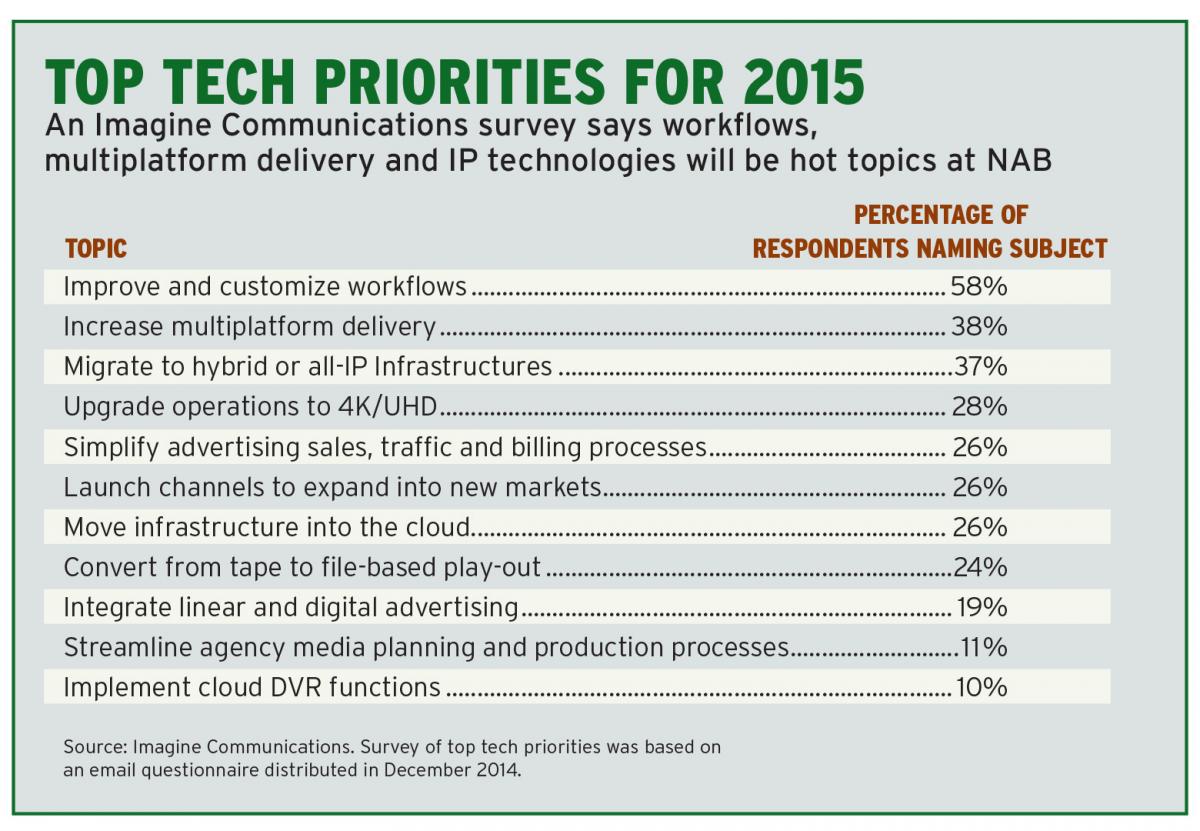Revolutionary Changes Come to Vegas

TV technologists will be heading to Las Vegas April 11-16 for the 2015 NAB Show facing some of the biggest changes the industry has confronted in decades, with vendors touting a host of new developments designed to revitalize the traditional TV business.
“The pace of change in this industry is arguably the faster that it has ever been,” says Michael Cronk, senior VP of strategic marketing, Grass Valley.
Charlie Vogt, CEO, Imagine Communications, who has been a major advocate of radically changing traditional broadcast infrastructures, agrees. “Our industry is experiencing once-in-a-generation change,” he says.
Vogt and others believe the industry needs to move away from expensive custom-built hardware and embrace the kind of infrastructures that have long been used by banks and major corporations. They believe broadcasters will eventually move their operations into data centers hosted in the cloud, where software systems will control inexpensive IT equipment and IP-based technologies.
Over time, this will allow broadcasters to capitalize on the huge sums tech giants spend each year on R&D in the $4 trillion IT sector, and provide a much more nimble, less costly infrastructure.
But this transition is likely to be years in the making and its immediate NAB impact is unclear. While the lure of these new technologies is likely to draw record Vegas attendance this year, a number of broadcasters may be hesitant to open up their checkbooks at a time when they face soft ad markets and declining ratings.
“Technology can’t just be about technology— it has to provide a business benefit,” says James Stellpflug, VP product marketing at EVS. Like many vendors, he stresses that they will be focusing on providing clients with a bridge to new IP technologies that will allow them to gain some of the benefits of the IP world without completely replacing existing systems.
Broadcasting & Cable Newsletter
The smarter way to stay on top of broadcasting and cable industry. Sign up below
Here are some of the major tech trends broadcasters will be discussing at next month’s show.
IP and the Cloud
As part of the transition to new types of broadcast infrastructure, all of the major vendors of broadcast equipment will be showing IP-based infrastructures, many of which will be cloud-based. “We’ve been investing heavily in IP technologies,” says Cronk of Grass Valley, which will be announcing IP developments on several products. “We view it as a means to an end so that many broadcasters can take their operation more towards a data center model.”
A number of product launches in this area are expected to be announced at NAB, but shortly before the market, Imagine Communications launched CloudXtream, an integrated IP video distribution platform for multichannel video programming distributors, programmers and the over-the-top service providers. It includes include live video, video-on-demand, cloud DVR, dynamic ad insertion, packaging, encoding, transcoding, storage management and cloud orchestration features, Vogt says.
While broadcasters have traditionally been reluctant to put key operations outside their main operations in the cloud, Maurizio Cimelli, managing director of the Deluxe MediaCloud, notes that improved security, reduced costs and simplified operations of cloud-based data center operations have radically changed those perspectives. “People are now starting to realize the cost of being locked into very expensive and complex traditional architectures,” he says. “They don’t want to have to spend a lot of money on [capital expenditures] and do a technology refresh every couple of years to keep up with market changes.”
While much of the interest in IP and cloud-based technologies go hand in hand, NAB will see a number of hybrid technologies to help manage the transition. Neil Maycock, VP of product strategy, Quantel notes that besides their major commitment to developing products for IP-based video, they are introducing interface cards that let existing products work with IP. “We are focused on facilitating technologies for broadcasters to make the transition,” he says.
Tom Lattie, VP product management at Harmonic, adds that they are offering cloudbased systems for virtualized playout. But they’ve also rolled out new products that can be deployed in traditional facilities that use their improved video processing software and have worked to combine more features into smaller but more powerful hardware. “It dramatically reduces the footprint and complexity of dealing with multiple vendors,” he says.
Media Management Platforms
The push to deliver more content to multiple platforms and the growing interest in IP- and cloud-based technologies has greatly accelerated the development of all-encompassing software platforms to handle and control a wide array of tasks. During the market, Avid, Dalet, Grass Valley, Harmonic, Imagine, Sony, Thompson Video Networks and others will be pitching software platforms to handle a wider array of broadcast and production operations.
“With all the changes in the consumption of video and the [shifting] value chain, [TV companies] have to be more efficient in how they create and distribute programming,” says Dana Ruzicka, VP of segment and product marketing at Avid. “The obvious answer to those pressures is a technology platform that ties all of these operations together.”
Other vendors are also expanding the range of features they offer to help streamline operations. Rick Young, VP and GM, sales and business development at Bitcentral, notes that they have long been focused on providing software to streamline workflows and that the recent acquisition of automation provider Fission Software will allow them to expand those features to automate more processes.
Beyond 4K
The show will once again see a host of new Ultra- HD or 4K technologies, particularly in the camera arena, where Sony, JVC, Canon, Panasonic and others will be showing new gear or improvements to their existing lineup.
Just before the market, Sony provided extensive firmware upgrades that will allow select cameras to offer wireless streaming, 4K QFHD recording and streamlined workflows, explains Alec Shapiro, president, professional solutions Americas, Sony North America. He stressed that the firmware upgrades are designed to protect the value of a user’s investment and to help them keep pace with changing production requirements.
Sony is also expected to show additional new 4K gear at the market, and to highlight improved workflows for their cameras, which are being used in a number of primetime TV shows. “The workflows for 4K are now established,” adds Rob Willox, senior marketing manager of content creation at the company.

During NAB, JVC will also be showing several new 4K cameras, the GY-LS300 Super 35mm camcorder, the GY-HM200, and the GY-HM170, which delivers 4K Ultra, says Larry Librach, senior VP for JVC Professional Video. “It puts us in the production and large sensor market,” says Librach.
Vendors are also working to develop full end-to-end workflows for 4K production. “All of our products, without exception, will have a 4K component,” says Jay Shinn, VP of FOR-A America, which will be launching a new production switcher, the HVS- 2000, and showing the newest version of its 4K variable frame rate camera, the FT-One-S.
With manufacturers launching new TV sets that have higher dynamic range (HDR) and wide-color gamut (WCG) for better picture quality, vendors are also preparing for the increased bandwidth and storage requirements those improvements will create. Alex Grossman, VP of media and entertainment at Quantum, estimates that HDR could increase 4K file sizes from 20% to 50%.
“How HDR will impact workflows will be a big question,” adds Shawn Carnahan, CTO of Telestream, who adds that they are continuing to put a lot of work into high-efficiency video coding, or HEVC, which can significantly reduce file sizes.
Keith Wymbs, chief marketing officer, Elemental Technologies, which has been involved in a number of major HEVC trials, adds that software and cloud-based technologies are providing their clients with much more flexibility in handling a wider array of formats.
“The evolution from fixed-purposed-based hardware to much more agile infrastructures will help companies quickly react to new consumer behavior and the competitive threat from over-the-top players,” he says.
